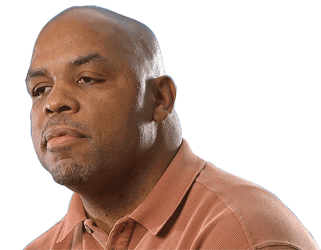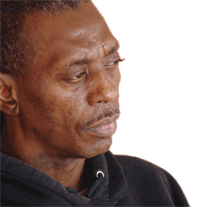printer-friendly PDF version  (313KB)
(313KB)
Do you know which group of people has the highest risk of oral cancer?
 African American men have the highest risk of developing oral cancer compared to any other group in the U.S. population.
African American men have the highest risk of developing oral cancer compared to any other group in the U.S. population.
Most cases of oral cancer are linked to cigarette smoking, heavy alcohol use, or the use of both tobacco and alcohol together. In fact, using tobacco plus alcohol poses a much greater risk than using either substance alone.
Certain types of human papillomavirus (HPV) may also play a part in oral cancer.
It’s not just smokeless tobacco (“dip” and “chew”). Using tobacco of any kind, including cigarettes, puts you at risk for oral cancer.
The risk of oral cancer increases with age. Most oral cancers occur after age 40.
What are the symptoms of oral cancer?
 Possible Signs & Symptoms
Possible Signs & Symptoms
- A sore, irritation, lump or thick patch in your mouth, lip, or throat
- A white or red patch in your mouth
- A feeling that something is caught in your throat
- Difficulty chewing or swallowing
- Difficulty moving your jaw or tongue
- Numbness in your tongue or other areas of your mouth
- Swelling of your jaw that causes dentures to fit poorly or become uncomfortable
- Pain in one ear without hearing loss
Be on the lookout for any changes in your mouth, especially if you smoke or drink.
What should you do if you have symptoms?
 See a doctor or dentist if any symptoms last more than 2 weeks.
See a doctor or dentist if any symptoms last more than 2 weeks.
Most often, symptoms (like those listed in the previous section) do not mean cancer. An infection or another problem can cause the same symptoms. But it’s important to get them checked out—because if you do have cancer, it can be treated more successfully if it’s caught early.
Ask for an oral cancer exam. It’s quick, painless, and it could save your life.
About Oral Cancer
The term oral cancer includes cancers of the mouth and the pharynx (FAIR-inks), part of the throat.
The Oral Cancer Exam
An oral cancer examination can detect early signs of cancer. The exam is painless—and takes only a few minutes. During the exam, your doctor or dentist will check your face, neck, lips, entire mouth, and the back of your throat for possible signs of cancer.
 “Are you at risk for oral cancer? What African American men need to know” is produced and distributed by the National Institute of Dental and Craniofacial Research in partnership with the National Cancer Institute, components of the National Institutes of Health (NIH) in Bethesda, Maryland. Part of the U.S. Department of Health and Human Services, NIH is one of the world’s foremost medical research centers and the federal focal point for medical research in the United States.
“Are you at risk for oral cancer? What African American men need to know” is produced and distributed by the National Institute of Dental and Craniofacial Research in partnership with the National Cancer Institute, components of the National Institutes of Health (NIH) in Bethesda, Maryland. Part of the U.S. Department of Health and Human Services, NIH is one of the world’s foremost medical research centers and the federal focal point for medical research in the United States.
NIH Publication No. 08-6101
This information is not copyrighted. Print and make as many photocopies as you need.
NOTE: PDF documents require the free Adobe Reader.